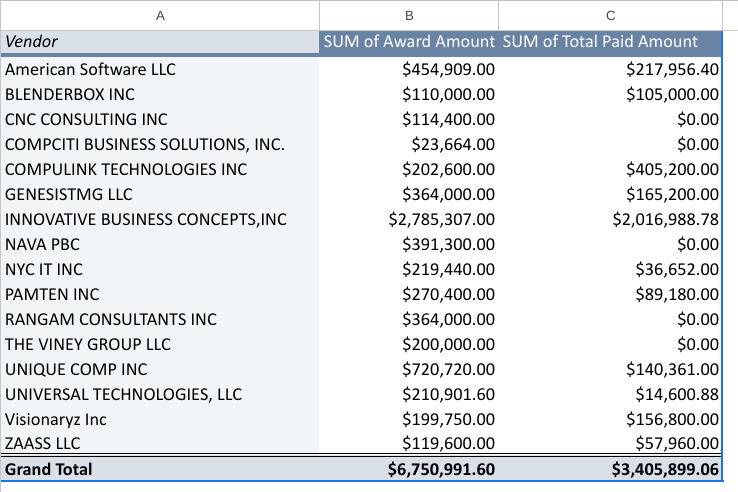Does Mayor Adams Know How to Reform the City’s Troubled IT Bureaucracy? MyCity Shows He Doesn’t

MyCity (photo: @nycgov)
When Bill de Blasio took office as Mayor in 2014, everyone knew government information technology agencies needed significant reform but didn’t know how exactly to do it. His predecessor, Mayor Bloomberg, was a venerated technology executive who had a hugely embarrassing software development fiasco called City Time happen under his watch. Barack Obama, the nation’s allegedly tech-savvy and youthful president, had a similarly high-profile failure with his HealthCare.gov website, which forced his Health and Human Services Secretary Kathleen Sebelius to resign and almost doomed the Affordable Care Act (ObamaCare) before it got started.
From the ashes of HealthCare.gov came, in 2014, a small and experimental unit within the Obama administration’s General Service Administration called 18F. It was organized and operated like an engineering-driven software startup within the government. Instead of signing lots of big contracts with proprietary software companies, 18F built common-sense tools using available open-source components, and posted its work to the code-sharing website Github so people could see the progress it made and reuse its code.
18F was, and continues to be, a massive success. By reliably delivering modern applications for dozens of federal agencies, its “digital service organizations (DSO)” model has been copied by national, state, and municipal governments throughout the United States and the world.
While top leadership in the de Blasio administration didn’t seem to be paying much attention to this new model for reforming technology bureaucracy, a few intrepid New York City civil servants did. They followed the 18F model to organize their own small teams within existing city agencies, but outside the city’s innovation-averse technology bureaucracy.
NYC Planning Labs within the Department of City Planning was a great example. It released a dozen tools, including popular products such as ZoLa and the Population Fact Finder.
NYC Opportunity was another. Operating within the Mayor’s Office of Economic Development, it delivered ACCESS NYC. Beyond offering access to “over 40 programs” and the ability to “apply directly for SNAP, Cash Assistance and Medicaid renewal” or “all 3 at the same time through the Cash Assistance application,” ACCESS NYC is also a masterclass in how a DSO-style team communicates about their product. They explain how it’s built, who it’s built by, and post links to Github repositories with code for its various components that would be helpful to future administrations who want to “leverage technology to improve the delivery of government services,” as Mayor Adams claims his administration is now doing.
Despite the successes of NYC Planning Labs and NYC Opportunity, de Blasio and his chief technology officer, John Paul Farmer, failed to organize a city-wide DSO to pursue IT reform. They did, however, announce an intention to do just that in December 2021, with less than a month left in de Blasio’s eight-year tenure.
When Mayor Adams took over, he recentralized the city technology bureaucracy under the Department of Information Technology and Telecommunication (DOITT), which he rebranded as the Office of Technology and Innovation (OTI), and put Matthew Fraser, a former NYPD Chief Information Officer and Gartner consultant, in charge. Looking at Adams' rhetoric and Fraser’s background, I saw no indication that they cared at all about the now-decade-old IT reform best practices established by 18F and similar DSOs around the country and world.
As a candidate, Adams campaigned on his plan for “MyCity,” an app that would consolidate residents’ enrollment in and interactions with New York City government into a single, streamlined portal. Somehow Adams seemed to convince people this was a new idea even though cities around the world have delivered apps like this to their residents, and NYC Opportunity’s ACCESS NYC app and open source components were already delivering much of the complex functionality Adams seemed to be envisioning.
This should have been great news for Adams. All he needed to do was to keep doing what was already working with ACCESS NYC, expand the scope of the app, rebrand it, and then market it with his unique flair as something new and exciting. It was a big fat pitch right down the middle of the plate. And he missed it.
On March 30, Adams announced the release of the first version of MyCity, and it is a dud with many of the classic hallmarks of a failed IT project: it is late and expensive, has fewer features than promised, and is built with proprietary technologies the city doesn’t own by over a dozen outside contractors. Let’s dig deeper, shall we?
First, MyCity is built on the proprietary and expensive Salesforce Experience Cloud. This means that the city has to pay Salesforce a licensing fee for as long as the city uses the site. It also means the investment in customizing the site is lost if and when the city wants, inevitably, to move to an open source system like ACCESS NYC that it actually owns and completely controls.
Second, the site is remarkably shallow considering it took over a year and millions of dollars to build. MyCity’s home page offers four sections: Child Care, Business, Jobs and Benefits, but only the Child Care section links further into the MyCity app. The Business section links to a site run by the Office of Small Business Administration. The Jobs section links to working.nyc.gov. The Benefits section links to ACCESS NYC at access.nyc.gov.
MyCity’s Child Care section has an eligibility screener that, after answering a few questions, directs the user to one of the two applications that MyCity apparently hosts. Before you access the applications, you are ejected to the NYC.ID login/registration flow. Presumably after that the magic happens where you access an online form wizard.
So, in summation, MyCity is, in its initial phase, a Salesforce-powered app with a short screener form, two benefits applications linked to a user’s NYC.ID, and a portal where a user can see the status of these two applications and any documents they’ve uploaded. How much did this cost the city?
Search Keyword: “MyCity” in the city’s recently released public view of Passport contracts. It shows over $6,750,000 awarded over 32 contracts to 15 different vendors, with $3,400,000 spent already.

Who are these vendors that the Adams administration thinks can do better than ACCESS NYC? I think that’s a great question worth investigating more. But the big winner here is clearly Innovative Business Concepts, Inc. It won seven contracts worth over $2.7 million, all of which were under the $500,000 threshold for small purchases, with two of those contracts starting, ending, and registered on the same day, each for $498,960. One is for “MyCity Portal - Development” and the other is for “MyCity Portal - Design.” (According to OTI, though the contracts are listed as Minority/Women-owned Business Enterprise non-competitive small purchase contracts, there was a competitive bidding process that involved multiple M/WBEs).

The Innovative Business Concepts website doesn’t have much information but does have a truly classic design and LinkedIn shows that it recently hired a former Assistant Deputy Commissioner of the NYC Department of Social Services and Human Resources Administration.

I’m not trying to suggest there is something out of the ordinary going on here. In fact, I’m suggesting the opposite: that MyCity is being executed the same, broken way that a myriad of other city IT projects have been executed.
If Mayor Adams wants to deliver the technology improvements he promised as a candidate, he needs to reorganize his technology bureaucracy to follow open source DSO principles.
***
Devin Balkind is a nonprofit executive, civic technologist, and startup advisor who ran for Public Advocate three times as the Libertarian Party nominee. On Twitter @DevinBalkind.
***
Have an op-ed idea or submission for Gotham Gazette? Email This email address is being protected from spambots. You need JavaScript enabled to view it.
Note - This article has been corrected to note that the contracts awarded to Innovative Business Concepts, Inc. went through a competitive bidding process involving multiple Minority/Women-owned Business Enterprises (M/WBEs). The contracts were not non-competitive as initially noted.
Good Cause Makes Good Sense for Harlem

In Harlem (photo: Ed Reed/Mayoral Photography Office)
As a New York State Senator serving Harlem and an Executive Director of a Harlem community organizing group, we have witnessed the rapid transformation of our neighborhood over the past several years and the wave of gentrification that has accompanied it.
For a century, Harlem has been a refuge for working-class Black families and other families of color. But today, those families are getting pushed out by rising costs — and not just out of the neighborhood, but out of New York altogether. Over the past two decades, more than 200,000 Black New Yorkers have left New York City – a 9% drop – pushed out by the skyrocketing cost of living.
New York’s diversity is its strength. In particular, Harlem's rich Black culture and numerous contributions to our nation and the world’s civil rights movement must be preserved. Black people have a median average income of $53,000 per year compared to $98,000 on average for white people. There has to be targeted income-based housing coupled with enhanced tenant protections in the upcoming state budget agreement in order to protect current residents and make it possible for working class Black people and future generations of Black families to stay in New York City. If we want to preserve Harlem as a safe harbor for working families, and not just a playground for the rich, we need help to protect renters in Harlem and across New York from even more displacement.
There is a solution. The state must pass ‘Good Cause Eviction’ to preserve the stability of the community. Right now, landlords of unregulated apartments in New York are able to evict tenants for any reason and raise the rent as high as they want. If a tenant complains about basic health concerns, like a lack of heat or pest infestations, a landlord can legally retaliate by refusing to renew their lease. Given that more than a third of rental units in Harlem are unregulated, the lack of protections has a huge impact. Residents in these units have no protections against corporate landlords trying to squeeze profits from renters.
Good cause eviction protections, currently being considered by the State Legislature in negotiations with Governor Hochul, would provide important safeguards for tenants against arbitrary or retaliatory evictions. Put simply, the law would require landlords to have a valid reason to evict them, and give tenants the power to take landlords to court if they suspect they’re being kicked out for unjust or retaliatory reasons.
And the bill limits exorbitant rent hikes by capping rent increases at the end of a lease to 3% or 150% of the Consumer Price Index, whichever is higher.
Good Cause would give tenants greater security and peace of mind in their homes, knowing that so long as they are lease-abiding, rent-paying tenants, their leases will be renewed. And it would be particularly valuable for Black women, who are evicted at twice the rate of white tenants.
The lack of tenant protections has caused tremendous hardship for low-income renters in Harlem. Too many residents cannot afford rent increases and find themselves in shelters or on the streets. And not only do evictions take a toll on renters themselves, but they reverberate across the entire neighborhood. Research shows that evictions increase crime rates, hurt public health, and make it harder for children to succeed in school.
And, Good Cause could be good for small landlords, especially homeowners of color, who are increasingly getting squeezed out of the market by corporate landlords and big investors. Today, 89% of all rental units in New York City are owned by corporations, and the average apartment in New York City is owned by a landlord with 900 units – not a mom-and-pop building owner. The law would dissuade corporate real estate profiteers from slapping tenants with outrageous rent increases like many people have seen in the past two years. In January, rents in Manhattan hit an all-time high, with median rent spiking 15% in a single year.
As people who know and love our community and our city, we want to protect Harlem renters – and all New York tenants – more than anything. While new growth and development is an essential part of any city, we must ensure that it doesn’t take an undue toll on existing residents or decimate the character of entire neighborhoods. To maintain the vibrancy of our city and make sure New York remains a place where people from all walks of life can live, we must pass Good Cause this year.
***
Senator Cordell Cleare was raised in Harlem and currently represents the 30th District of the New York State Senate. Juanita O. Lewis is the Executive Director of Community Voices Heard, a statewide, grassroots organizing nonprofit based in Harlem. On Twitter @SenatorCCleare & @CVHAction.
***
Have an op-ed idea or submission for Gotham Gazette? Email This email address is being protected from spambots. You need JavaScript enabled to view it.
Stopping the Crime Wave in the Construction Industry

Construction workers need protection (photo: Ed Reed/Mayor's Office)
There’s a crime wave affecting hard-working New Yorkers that you won’t hear about on cable news. Construction contractors are using underhanded schemes, shell companies, shady bank accounts, and check-cashing stores to avoid paying employees the full pay they have earned. In New York, that adds up to $1 billion in wages lost every year, impacting tens of thousands of workers.
As Americans finish filing their income taxes this week, consider that tax fraud in the construction industry adds up to more than $8.4 billion every year in lost federal and state tax revenue. Funds that should be going to fund police and emergency services, build schools, or help veterans are instead lining the pockets of wealthy developers who refuse to play by the rules.
Getting cheated out of wages is an all-too-common experience for construction workers, and with 528,000 New Yorkers employed by the construction industry – about 1 in 18 workers statewide – this is an issue that hits close to home for thousands of families in the Empire State.
Law enforcement officials across New York are stepping up to fight this crime wave, but more needs to be done in Albany to strengthen existing laws.
At the state level, the Construction Wage Theft Task Force is a coordinated effort among the NYS Department of Labor (NYSDOL), the New York State Attorney General, and local District Attorneys to combat corruption and crime within the construction industry. Due in part to the efforts of this task force, the NYSDOL has recovered more than $360 million in stolen wages over the past decade.
At the county level, aggressive district attorneys are also cracking down on wage theft. During his tenure as president of the District Attorneys Association of New York, Orange County District Attorney David Hoovler made fighting tax fraud a top priority. Just a few weeks ago, Manhattan District Attorney Alvin Bragg announced his office’s first-ever Worker Protection Unit to investigate and prosecute wage theft. That new unit builds on the success of his predecessor’s Construction Fraud Task Force.
In Albany, there is a renewed push to toughen penalties for stolen wages. A bill introduced by Senator Neil Breslin and Assemblymember Catalina Cruz would amend the penal law in relation to wage theft. This legislation would enable prosecutors to charge larceny for stolen wages, which is a much more serious felony charge than a typical “scheme to defraud” that might be charged today.
It makes sense – why should a rich contractor get off easier than a petty thief if they both end up stealing a day’s wages from a construction worker?
We hear a lot lately about rising crime, but wage theft is one that stays under the radar. The offenders rely on their victims to stay silent, threatening future employment opportunities and using their power and influence to evade accountability. That’s coming to end, because more and more people understand that workers aren’t the only ones being cheated. Stopping wage theft is good for business, it’s good for blue collar workers, and it’s good for New York’s economy.
***
Bill Banfield is Assistant to the Executive Secretary-Treasurer of the North Atlantic States Regional Council of Carpenters (NASRCC), the union representing more than 30,000 men and women employed by the leading residential and commercial general contractors and carpentry subcontractors in the region.
***
Have an op-ed idea or submission for Gotham Gazette? Email This email address is being protected from spambots. You need JavaScript enabled to view it.




